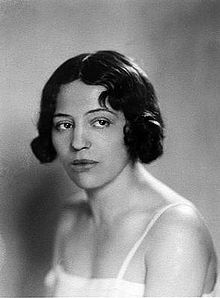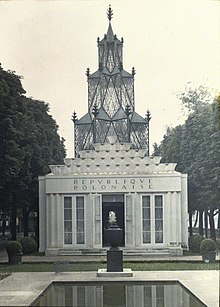Zofia Stryjeńska
Zofia Stryjeńska b. Lubańska (born May 13, 1891 in Krakow ; † February 28, 1976 in Geneva ) was a Polish painter , graphic artist , illustrator , set designer and representative of Art Déco . She was married to the architect Karol Stryjeński.
biography
Since childhood, Zofia Stryjeńska has drawn and painted a lot. As a young woman, she worked for the newspapers “Rola” and “Głos Ludu”. In 1909 she studied at the “Maria Niedzielska” art school for women. In 1911 she graduated from the course with awards for painting and applied arts . In 1910 she traveled with her father via Austria-Hungary to Italy and visited galleries in Vienna and Venice .
On October 1, 1911, she began - disguised as a boy and under the name Tadeusz Grzymała Lubański - to study at the Academy of Fine Arts in Munich (women were not allowed there at that time). After a year her disguise was discovered and she left Munich to return to Krakow, where she devoted herself intensively to painting and literature.
In May 1913, the art critic Jerzy Warchałowski described in detail the merits of Zofia Stryjeńska in the newspaper “Czas”, thereby promoting the young artist. At this time she came into the circle of the intelligentsia and bohemian Krakow: She got to know the families Żeleński , Jachimecki, Puszet and Kossak . She became friends with Magdalena Samozwaniec and her sister Maria Pawlikowska-Jasnorzewska .
On November 4, 1916, she secretly married the architect and Zakopane lover Karol Stryjeński . She had three children with him: daughter Magda and twins Jacek and Jan.
Stryjeński introduced his wife to his circle of friends of artists and representatives of world literature. At that time she met among others Władysław Skoczylas , Henryk Kuna , Stefan Żeromski , Władysław Reymont , Stanisław Ignacy Witkiewicz and a few years later some poets of the Skamander know.
In 1921–1927 she lived in Zakopane, where her husband worked as the director of the school of woodworking. During this period of time, which was initially happy and productive, more and more serious differences of opinion arose with Karol over the years, and finally there was an open conflict that ended with the divorce in 1927.
After the divorce she moved to Warsaw, where she married the actor Artur Socha in 1929. This marriage also turned out to be unhappy. The painter worked hard to support the children and husband during the crisis. After a few years they divorced again. At the end of the 1930s there was a liaison with the architect and bon vivant Achilles Breza, and then with the writer Arkady Fiedler.
In 1936 she was awarded the Golden Laurel of the Polish Literature Academy. In deep poverty she was forced to sell some pictures to usurers at ridiculous prices. It wasn't until 1938 that she received some orders from the Foreign Ministry, including a. for a carpet for the Japanese emperor Hirohito. She also created paintings for the passenger ships “Batory” and “Piłsudski”.
She spent the war years in Krakow. After the end of the war she decided to leave Poland. She moved to live with her daughter in Switzerland, and later her sons joined them. She tried to come to the United States, but the Kościuszko Foundation board failed to provide any help. She stayed in Geneva and lived there in poor conditions. She died in Geneva and was buried in the Chenebourg cemetery.
Artistic creation
She is known as the “Princess of Polish Art” ( Mieczysław Grydzewski ).
Mostly she used the painting technique tempera ; but she also dealt with lithography , drawings and posters . She developed toys and tapestries and created exquisite illustrations.
She was responsible for the design of the Polish pavilion at the 1925 World's Fair in Paris. This consisted of the cycle “Twelve Months” (six paintings, two months per canvas), which showed the rural work that was characteristic of the individual months. This work made the artist famous in Europe and brought her five awards at the world exhibition.
Thanks to the numerous works depicting Slavic gods , she is considered to be the forerunner of Slavic Neopaganism in Poland - but it should be mentioned that the artist always saw herself as a Christian . She was of a Catholic upbringing and conviction, although she briefly switched to Protestantism in order to get divorced and remarry. So your fascination for the old Slavic belief is purely artistic.
Literary work
Stryjeńska wanted to teach her children good manners and wrote a textbook on manners under the pseudonym Prof. Hilar .
The artist's diaries were published under the title Chleb prawie że powszedni ( Eng . Almost Daily Bread).
The master of the brush was also a master of the pen, as can be seen from her personal writings, which are characterized by freedom of language and richness of words.
reception
A huge retrospective exhibition by Zofia Stryjeńska - the first after the monographic presentation of the artist's works in 1945 - was organized in the National Museum in Cracow in 2008 ; In 2009 the National Museum in Poznan and the National Museum in Warsaw presented this exhibition. The exhibition was accompanied by a richly illustrated and bibliophile catalog edited by Światosław Lenartowicz, the curator of the exhibition.
portrait
- Poland: Commemorative coin in plaque form, 2011, silver-925 fine, 28:40 mm, 28.28 g.
- Poland: commemorative coin with a face value of 2 złoty, 2011 of the National Bank of Poland.
Web links
| personal data | |
|---|---|
| SURNAME | Stryjeńska, Zofia |
| ALTERNATIVE NAMES | Lubańska, Zofia (maiden name) |
| BRIEF DESCRIPTION | Polish painter |
| DATE OF BIRTH | May 13, 1891 |
| PLACE OF BIRTH | Krakow |
| DATE OF DEATH | February 28, 1976 |
| Place of death | Geneva |


